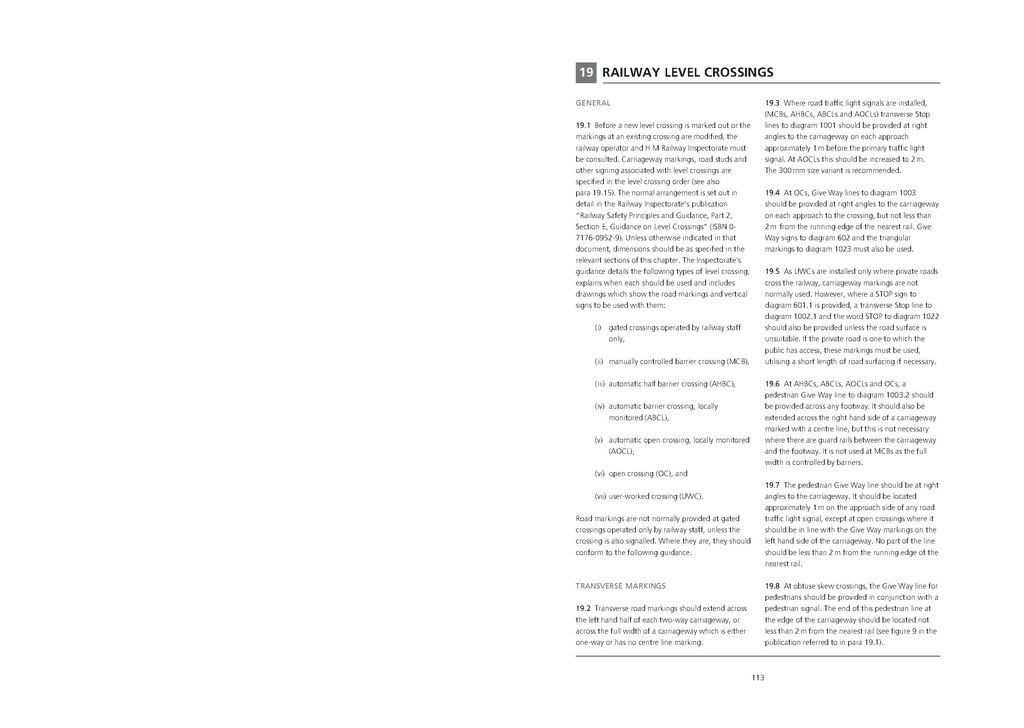19RAILWAY LEVEL CROSSINGS
GENERAL
19.1 Before a new level crossing is marked out or the markings at an existing crossing are modified, the railway operator and H M Railway Inspectorate must be consulted. Carriageway markings, road studs and other signing associated with level crossings are specified in the level crossing order (see also para 19.15). The normal arrangement is set out in detail in the Railway Inspectorate’s publication "Railway Safety Principles and Guidance, Part 2, Section E, Guidance on Level Crossings" (ISBN 07176-0952-9). Unless otherwise indicated in that document, dimensions should be as specified in the relevant sections of this chapter. The Inspectorate's guidance details the following types of level crossing, explains when each should be used and includes drawings which show the road markings and vertical signs to be used with them:
(i)gated crossings operated by railway staff only,
(ii) manually controlled barrier crossing (MCB),
(iii) automatic half barrier crossing (AHBC),
(iv) automatic barrier crossing, locally monitored (ABCL),
(v) automatic open crossing, locally monitored (AOCL),
(vi) open crossing (OC), and
(vii) user-worked crossing (UWC).
Road markings are not normally provided at gated crossings operated only by railway staff, unless the crossing is also signalled. Where they are, they should conform to the following guidance.
TRANSVERSE MARKINGS
19.2 Transverse road markings should extend across the left hand half of each two-way carriageway, or across the full width of a carriageway which is either one-way or has no centre line marking.
19.3 Where road traffic light signals are installed, (MCBs, AHBCs, ABCLs and AOCLs) transverse Stop lines to diagram 1001 should be provided at right angles to the carriageway on each approach approximately 1 m before the primary traffic light signal. At AOCLs this should be increased to 2 m. The 300 mm size variant is recommended.
19.4 At OCs, Give Way lines to diagram 1003 should be provided at right angles to the carriageway on each approach to the crossing, but not less than 2 m from the running edge of the nearest rail. Give Way signs to diagram 602 and the triangular markings to diagram 1023 must also be used.
19.5 As UWCs are installed only where private roads cross the railway, carriageway markings are not normally used. However, where a STOP sign to diagram 601.1 is provided, a transverse Stop line to diagram 1002.1 and the word STOP to diagram 1022 should also be provided unless the road surface is unsuitable. If the private road is one to which the public has access, these markings must be used, utilising a short length of road surfacing if necessary.
19.6 At AHBCs, ABCLs, AOCLs and OCs, a pedestrian Give Way line to diagram 1003.2 should be provided across any footway. It should also be extended across the right hand side of a carriageway marked with a centre line, but this is not necessary where there are guard rails between the carriageway and the footway. It is not used at MCBs as the full width is controlled by barriers.
19.7 The pedestrian Give Way line should be at right angles to the carriageway. It should be located approximately 1 m on the approach side of any road traffic light signal, except at open crossings where it should be in line with the Give Way markings on the left hand side of the carriageway. No part of the line should be less than 2 m from the running edge of the nearest rail.
19.8 At obtuse skew crossings, the Give Way line for pedestrians should be provided in conjunction with a pedestrian signal. The end of this pedestrian line at the edge of the carriageway should be located not less than 2 m from the nearest rail (see figure 9 in the publication referred to in para 19.1).
113
